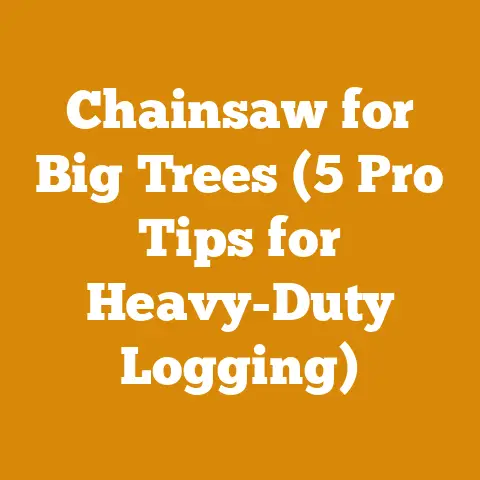Clearing Undergrowth by Hand: Essential Wood Processing Tools (Pro Tips)
As someone who’s spent decades in the woods, from my early days helping my grandfather thin his overgrown apple orchard to managing timber stands on my own property, I understand the satisfaction – and the necessity – of clearing undergrowth. It’s not just about aesthetics; it’s about forest health, fire prevention, and creating usable space. Whether you’re a homeowner reclaiming your backyard, a small-scale logger managing a woodlot, or simply someone who enjoys the meditative rhythm of working with wood, understanding the right tools and techniques for clearing undergrowth by hand is essential. This isn’t just about brute force; it’s about efficiency, safety, and respecting the resources you’re working with. Let’s dive into the world of essential wood processing tools for clearing undergrowth, sharing pro tips and techniques I’ve learned over the years.
Clearing Undergrowth by Hand: Essential Wood Processing Tools (Pro Tips)
Clearing undergrowth by hand is a fundamental skill for anyone involved in wood processing, logging, or firewood preparation. It’s a task that ranges from removing small saplings and brush to dealing with larger, fallen branches and small trees. The right tools and techniques not only make the job easier but also safer and more efficient. In this guide, I’ll walk you through the essential tools, provide step-by-step instructions, and share pro tips to help you tackle any undergrowth clearing project.
Why Clear Undergrowth? The Importance of Forest Management
Before we get into the tools and techniques, let’s understand why we clear undergrowth in the first place. It’s more than just tidying up.
- Forest Health: Overcrowded undergrowth can stifle the growth of larger trees by competing for sunlight, water, and nutrients. Removing excess vegetation allows desirable trees to thrive.
- Fire Prevention: Dense undergrowth is a major fire hazard. Removing deadwood, dry brush, and low-hanging branches reduces the fuel load, making it less likely for a fire to start and spread rapidly.
- Accessibility: Clearing undergrowth makes it easier to navigate your property, whether you’re hiking, hunting, or managing timber.
- Aesthetics: A well-maintained woodland is simply more beautiful and enjoyable.
- Wildlife Habitat: While dense undergrowth provides cover for some animals, excessive growth can limit biodiversity. Selective clearing can create a more diverse habitat that supports a wider range of species.
Key Definitions: Understanding the Basics
To ensure we’re on the same page, let’s define some key terms:
- Undergrowth: This refers to the shrubs, saplings, vines, and ground cover that grow beneath the canopy of taller trees.
- Green Wood: Freshly cut wood that still contains a high moisture content. Green wood is generally easier to split than seasoned wood, but it’s also heavier and more prone to warping and rot.
- Seasoned Wood: Wood that has been allowed to dry, reducing its moisture content. Seasoned wood burns more efficiently and produces less smoke.
- Hardwood: Wood from deciduous trees (trees that lose their leaves in the fall), such as oak, maple, and ash. Hardwoods are generally denser and burn longer than softwoods.
- Softwood: Wood from coniferous trees (trees that have needles and cones), such as pine, fir, and spruce. Softwoods are generally easier to cut and split, but they burn faster.
Essential Tools for Clearing Undergrowth by Hand
Here’s a rundown of the tools I consider essential for clearing undergrowth by hand, along with my recommendations based on years of experience:
- Chainsaw: Indispensable for cutting larger branches and small trees.
- My Pick: Stihl MS 271 Farm Boss. It’s a powerful, reliable saw that can handle a wide range of tasks.
- Specifications: 50.2 cc engine, 20-inch bar, weighs approximately 12.3 lbs.
- Pro Tip: Invest in high-quality chainsaw chains and keep them sharp. A dull chain is dangerous and inefficient. I prefer Oregon chains.
- Axes: For splitting wood and felling smaller trees.
- Splitting Axe: Designed with a wider head and a convex blade for splitting logs.
- My Pick: Fiskars X27 Splitting Axe. It’s lightweight, durable, and incredibly effective.
- Specifications: 36-inch handle, 6.5 lbs weight.
- Felling Axe: Designed with a sharper, thinner blade for felling trees.
- My Pick: Gränsfors Bruks Scandinavian Forest Axe. These are expensive, but the quality is unmatched.
- Specifications: 25-inch handle, 2 lbs weight.
- Splitting Axe: Designed with a wider head and a convex blade for splitting logs.
- Bow Saw: A lightweight and versatile saw for cutting smaller branches and saplings.
- My Pick: Bahco 24-inch Ergo Bow Saw. It’s easy to use and provides clean, efficient cuts.
- Specifications: 24-inch blade, lightweight steel frame.
- Pro Tip: Keep a spare blade on hand, as bow saw blades can break easily.
- Loppers: Long-handled pruning shears for cutting branches up to 2 inches in diameter.
- My Pick: Felco 210A-60 Loppers. Durable, powerful, and easy to maintain.
- Specifications: 24-inch handles, cuts up to 1.6-inch diameter branches.
- Pruning Shears: For trimming smaller branches and shrubs.
- My Pick: Felco F-8 Classic Pruning Shears. The industry standard for a reason.
- Specifications: Ergonomic design, cuts up to 1-inch diameter branches.
- Brush Axe (Brush Hook): A versatile tool for clearing brush, small saplings, and vines.
- My Pick: Council Tool Brush Axe. A classic and reliable tool.
- Specifications: 36-inch handle, 14-inch blade.
- Pro Tip: Learn to sharpen the blade properly. A sharp brush axe is much safer and more effective.
- Machete: Similar to a brush axe but with a longer, thinner blade. Useful for clearing dense vegetation.
- My Pick: Tramontina Machete. Affordable and durable.
- Specifications: 18-inch blade, wooden handle.
- Peavey/Cant Hook: Essential for moving and positioning logs.
- My Pick: Peavey Manufacturing Peavey. A reliable and durable tool.
- Specifications: Available in various lengths, typically 3-5 feet.
- Wedges: Used in conjunction with an axe to split larger logs.
- My Pick: Estwing Sure Split Wedge. Durable and effective.
- Specifications: Forged steel construction.
- Sledgehammer: For driving wedges into logs.
- My Pick: Estwing Sledge Hammer. Durable and reliable.
- Specifications: Available in various weights, typically 8-12 lbs.
- Personal Protective Equipment (PPE): Absolutely essential for safety.
- Safety Glasses: Protect your eyes from flying debris.
- Hearing Protection: Chainsaws and other power tools can cause hearing damage.
- Gloves: Protect your hands from cuts and splinters.
- Steel-Toed Boots: Protect your feet from falling logs and sharp objects.
- Chainsaw Chaps: Essential when using a chainsaw to protect your legs from injury.
- Helmet: Protect your head from falling branches.
- First Aid Kit: For treating minor injuries.
- My Recommendation: A well-stocked kit with bandages, antiseptic wipes, pain relievers, and a tourniquet.
Step-by-Step Guide to Clearing Undergrowth by Hand
Now that we have our tools, let’s get to work. Here’s a step-by-step guide to clearing undergrowth by hand:
Step 1: Assessment and Planning
- Walk the Area: Before you start cutting, walk the area you plan to clear and identify any potential hazards, such as power lines, fences, or hidden obstacles.
- Identify Desirable Trees: Mark any trees you want to keep, so you don’t accidentally cut them down. I use flagging tape for this.
- Plan Your Approach: Decide on the best way to clear the undergrowth. Consider the size and density of the vegetation, the terrain, and the tools you have available.
Step 2: Safety First
- Wear PPE: Always wear appropriate personal protective equipment, including safety glasses, hearing protection, gloves, steel-toed boots, chainsaw chaps (if using a chainsaw), and a helmet.
- Clear the Work Area: Remove any obstacles that could trip you or interfere with your work.
- Be Aware of Your Surroundings: Pay attention to your surroundings and be aware of any potential hazards, such as falling branches or wildlife.
- Never Work Alone: It’s always safer to work with a partner, especially when using a chainsaw.
Step 3: Clearing Small Brush and Saplings
- Use Loppers or Pruning Shears: For small branches and saplings up to 2 inches in diameter, use loppers or pruning shears to cut them at ground level.
- Use a Brush Axe or Machete: For denser brush and saplings, use a brush axe or machete to clear the vegetation. Swing the tool in a controlled manner, keeping your body out of the path of the blade.
- Technique: When using a brush axe, I like to use a chopping motion, aiming for the base of the sapling. For denser brush, a sweeping motion can be more effective.
- Pile the Brush: As you clear the brush, pile it in a designated area for later disposal.
Step 4: Cutting Larger Branches and Small Trees
- Use a Bow Saw: For branches and saplings larger than 2 inches in diameter, use a bow saw to cut them at ground level.
- Technique: Use a smooth, even sawing motion. Avoid forcing the saw, as this can cause the blade to bind.
- Use a Chainsaw: For larger branches and small trees, use a chainsaw.
- Important: If you’re not experienced with using a chainsaw, it’s essential to get proper training before attempting to fell trees.
- Felling Technique (Basic):
- Assess the Tree: Determine the direction of lean and identify any hazards, such as branches that could fall on you.
- Clear the Area: Clear any brush and obstacles around the base of the tree.
- Make a Notch: Cut a notch on the side of the tree in the direction you want it to fall. The notch should be about one-third of the tree’s diameter.
- Make a Back Cut: Cut from the opposite side of the tree, slightly above the notch. Leave a hinge of wood to control the direction of the fall.
- Push the Tree: As the tree begins to fall, move away from the base and watch for any falling branches.
- Pro Tip: Always have an escape route planned before you start cutting.
Step 5: Processing Fallen Trees and Branches
- Limbing: Remove the branches from the fallen tree using a chainsaw or axe.
- Technique: Work from the base of the tree towards the top, cutting the branches close to the trunk.
- Bucking: Cut the trunk into manageable lengths for firewood or other uses.
- Technique: Use a chainsaw to cut the trunk into desired lengths.
- Splitting: Split the logs into smaller pieces for firewood using a splitting axe and wedges (if necessary).
- Technique: Position the log on a chopping block and swing the splitting axe with a controlled motion. If the log is difficult to split, use wedges and a sledgehammer to drive them into the log.
Step 6: Stacking and Seasoning Firewood
- Stack the Firewood: Stack the firewood in a well-ventilated area to allow it to dry.
- Stacking Methods: There are several methods for stacking firewood, including:
- Traditional Row Stacking: Stacking the wood in rows, leaving space between the rows for air circulation.
- Holz Hausen: A circular stack of wood that provides excellent air circulation and stability.
- Swedish Torch: A single log that is partially cut and burned from the inside out.
- My Preferred Method: I prefer traditional row stacking with a slight lean inwards for stability.
- Stacking Methods: There are several methods for stacking firewood, including:
- Season the Firewood: Allow the firewood to season for at least six months, or preferably a year, before burning it.
- Moisture Content: The ideal moisture content for firewood is below 20%. You can use a moisture meter to check the moisture content of the wood.
- Benefits of Seasoned Wood: Seasoned wood burns more efficiently, produces less smoke, and reduces the risk of creosote buildup in your chimney.
Step 7: Disposal of Brush and Debris
- Burning: If local regulations allow, you can burn the brush and debris in a controlled burn.
- Important: Obtain any necessary permits and follow all safety guidelines.
- Chipping: You can rent or hire a wood chipper to chip the brush and debris into mulch.
- Composting: Smaller branches and leaves can be composted.
- Hauling: You can haul the brush and debris to a local landfill or recycling center.
Case Study: Reclaiming an Overgrown Backyard
I once helped a friend reclaim his overgrown backyard, which had been neglected for several years. The undergrowth was dense and consisted of a mix of thorny bushes, small saplings, and deadwood. Here’s how we tackled the project:
- Assessment: We started by walking the area and identifying the trees he wanted to keep. We marked them with flagging tape.
- Safety: We both wore appropriate PPE, including safety glasses, gloves, and steel-toed boots.
- Clearing Small Brush: We used loppers and pruning shears to clear the smaller brush and thorny bushes. This was the most tedious part of the job, but it made it easier to access the larger saplings.
- Cutting Saplings: We used a bow saw to cut the saplings up to 4 inches in diameter. For the larger saplings, we used a chainsaw.
- Processing Fallen Trees: We limbed and bucked the fallen trees into manageable lengths.
- Splitting Firewood: We split the logs into firewood using a splitting axe and wedges.
- Stacking Firewood: We stacked the firewood in a well-ventilated area to season.
- Disposal: We rented a wood chipper to chip the remaining brush and debris into mulch, which we used to improve the soil around the trees.
The project took us two weekends to complete, but the results were dramatic. The backyard was transformed from an overgrown jungle into a usable and enjoyable space.
Pro Tips for Efficient Undergrowth Clearing
Here are some pro tips I’ve learned over the years to make undergrowth clearing more efficient and safer:
- Sharpen Your Tools Regularly: Sharp tools are safer and more efficient. Invest in a good sharpening kit and learn how to sharpen your axes, brush axes, and chainsaw chains.
- Use the Right Tool for the Job: Don’t try to use a pruning shear to cut a 4-inch branch. Use the appropriate tool for the task at hand.
- Work in Sections: Divide the area you want to clear into smaller sections and focus on completing one section at a time. This will make the task seem less daunting.
- Take Breaks: Clearing undergrowth is physically demanding work. Take frequent breaks to avoid fatigue and prevent injuries.
- Stay Hydrated: Drink plenty of water, especially on hot days.
- Be Aware of Wildlife: Be aware of the presence of wildlife, such as snakes, insects, and ticks. Take precautions to avoid being bitten or stung.
- Consider the Season: The best time to clear undergrowth is during the dormant season (late fall or winter) when the vegetation is less active and the insects are less prevalent.
- Learn from Others: Talk to experienced loggers, foresters, or landowners to learn about their techniques and best practices.
- Practice Proper Lifting Techniques: When lifting heavy logs or branches, use proper lifting techniques to avoid back injuries. Keep your back straight, bend your knees, and lift with your legs.
- Invest in Quality Tools: While it may be tempting to save money by buying cheap tools, investing in high-quality tools will pay off in the long run. Quality tools are more durable, more efficient, and safer to use.
- Maintain Your Tools: Keep your tools clean, lubricated, and in good working order. This will prolong their life and ensure they perform optimally.
- Consider a Hydraulic Log Splitter: If you process a lot of firewood, consider investing in a hydraulic log splitter. It will save you a lot of time and energy. I personally use a 27-ton splitter and it’s one of the best investments I’ve made.
- Know Your Wood: Learning to identify different types of wood can help you determine the best way to process them. For example, some woods split more easily than others. Knowing the difference between oak, maple, and birch will help you optimize your firewood processing.
- Leave Some Habitat: While clearing undergrowth is important for forest health and fire prevention, it’s also important to leave some habitat for wildlife. Consider leaving some brush piles or standing dead trees to provide cover and nesting sites for animals.
- Consider a Wood Moisture Meter: A wood moisture meter is a valuable tool for determining the moisture content of firewood. This will help you ensure that your firewood is properly seasoned before burning it.
- Think About Slope and Drainage When Stacking: When stacking firewood, consider the slope and drainage of the area. Avoid stacking wood in areas that are prone to flooding or that have poor drainage. This will help prevent the wood from rotting.
Strategic Advantages of Hand Clearing
While mechanized clearing has its place, hand clearing offers several strategic advantages:
- Precision: Hand clearing allows you to be more selective about what you remove, preserving desirable vegetation and wildlife habitat.
- Reduced Soil Disturbance: Hand clearing minimizes soil disturbance, which can help prevent erosion and protect water quality.
- Cost-Effectiveness (Small Scale): For small-scale projects, hand clearing can be more cost-effective than renting or hiring heavy equipment.
- Quiet Operation: Hand clearing is much quieter than mechanized clearing, which can be important in residential areas or sensitive environments.
- Exercise: Let’s be honest, it’s a great workout!
Costs, Materials, and Timing
- Tool Costs: The cost of the essential tools for clearing undergrowth by hand can range from a few hundred dollars to several thousand dollars, depending on the quality and type of tools you choose.
- Material Costs: Material costs are relatively low, primarily consisting of fuel for the chainsaw and wedges for splitting logs.
- Timing: The time it takes to clear undergrowth by hand depends on the size and density of the vegetation, the terrain, and your level of experience.
- Access to Resources: Access to quality tools and equipment can be limited in some areas.
- Funding: Securing funding for equipment and training can be difficult for small businesses.
- Regulations: Navigating local regulations regarding tree felling, burning, and disposal of debris can be complex.
- Training: Access to proper training in chainsaw safety, felling techniques, and wood processing can be limited.
- Safety: Working in remote areas can be dangerous, with limited access to medical assistance.
- Environmental Concerns: Balancing the need to clear undergrowth with the need to protect the environment can be challenging.
Next Steps: Getting Started
Ready to tackle your own undergrowth clearing project? Here are some practical next steps:
- Assess Your Needs: Determine the scope of your project and the tools you’ll need.
- Invest in Quality Tools: Purchase the essential tools and equipment, prioritizing safety and durability.
- Get Training: If you’re not experienced with using a chainsaw or other power tools, get proper training from a qualified instructor.
- Plan Your Approach: Develop a detailed plan for clearing the undergrowth, including safety precautions, disposal methods, and a timeline.
- Start Small: Begin with a small section of the area you want to clear and gradually work your way through the entire project.
- Stay Safe: Always wear appropriate PPE and follow all safety guidelines.
- Enjoy the Process: Clearing undergrowth can be hard work, but it’s also a rewarding experience. Enjoy the fresh air, the exercise, and the satisfaction of transforming your property.
Clearing undergrowth by hand is a skill that connects you to the land. It’s about understanding the ecosystem, respecting the resources, and working with purpose. Whether you’re a seasoned logger or a homeowner with a small backyard, the right tools, techniques, and a commitment to safety will make the job easier, more efficient, and ultimately, more rewarding. So, get out there, sharpen your tools, and start clearing! Remember to always prioritize safety and respect the environment. Your efforts will contribute to a healthier, more beautiful, and more sustainable landscape.






